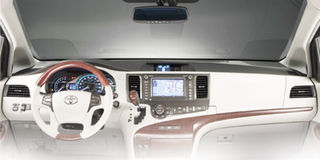Premium
The dashboard alphabet

Just as quickly as we hopped behind the wheel must we pop back out, but only briefly. Why? The less informed among us might have encountered a challenging array of letters, anagrams, and devices across the dashboard, most of which do not make sense unless explained.
ABS? EBD? ESP? T/C? C.Diff Auto? AWC? O/D? What the hell could these be, besides possible combinations in a game of Scrabble that is not going too well for the player?
Let us start with the most misunderstood, and frequently misused, the O/D system, also known as overdrive (and not overdose).
Overdrive
The easiest way to define overdrive is as a supplementary gear, taller than top, and hence makes the engine over-geared (thus overdrive) when engaged.
It is a mechanical unit, sometimes mechanically controlled (such as in older cars and manual transmission vehicles) using a lever, or electronically managed, such as in most latter-day automatics. The overdrive unit can be used either as stand-alone gear, such as in manual cars like the Ford F-250 XLT (1-2-3-4-O/D) or the old E23 Nissan Urvan, or as an additional unit in the gear box itself, which supplies intermediate gears.
How do you use it? Engage it in simple driving, because the engine spins at lower rpm for a particular gear, reducing strain and increasing fuel economy.
Turn it off when towing, carrying heavy loads, going up a steep hill or when you want to accelerate really hard. In most cars, it is on by default, just like the traction control systems, and pressing the button turns it OFF, accompanied by a warning light on the dashboard saying “O/D OFF”. Keep it on if you don’t practise any of the above techniques. The mechanical functions of the overdrive unit will be discussed in detail later.
ABS
ABS is an anti-lock braking system, but the acronym itself is actually derived from a German term, not an English one (anti-blockiër system). When braking very hard, it is very easy to lock the brakes, i.e. the brake pads clamp shut and cause the affected tyre(s) to skid. A skidding tyre is not good for several reasons: understeer is one in case you were charging into a corner, oversteer in case you were charging out of it.
If you were going in a straight line, the vehicle will pull towards the direction of the locked tyre. Spinning is possible. And, self-defeatingly, the braking effect is not as good as it should be, meaning you will travel further than you intended before coming to halt. Can someone please say screech, crash, bang, smash, blood, tears, police reports, and insurance claims?
This undesirable scenario led automotive engineers to invent ABS, which works like this: when active, applying the brakes does not clamp the brake shoes in a single vice-like grip, the application is more of a pulsating effect, a drum-like tattoo as the shoes clamp and unclamp in rapid succession, up to several times per second. This prevents the brakes from locking up and the tyre skidding.
Don’t think that this makes the car rock back and forth, as it would if you pumped the brakes on and off yourself: the rhythm of on-off action is unsynchronised for all wheels, i.e. as one wheel brake clamps on, the other unclamps, out of unison, creating an overall smooth pattern.
Electrical engineers can identify with this other explanation: rectifying an AC voltage overall creates a single smooth line out of the peaks of several sine waves. In some cars, particularly some overused Toyotas, it is possible to feel the pulsation of the brakes through the pedal when stepping hard on it.
The system works through a maze of valves and speed sensors, a pump and a controller. Its exact mode of operation calls for an article of its own, so let us leave it at that for now.
Should you be compelled to stand on the brakes and the ABS blinker lights up on the dash, know that the system is working hard and you need to be careful. ABS prevents locking of the brakes, but it does not increase their stopping power, especially on loose surfaces.
If anything, ABS marginally increases the braking distance through that on-off ballet. The most effective braking technique (getting the most out of your anchors) is called threshold braking, whereby the driver is required to apply the brakes right up to the point where they start locking and then releasing them a tiny fraction. This point is the threshold (hence the name) beyond which your brakes lock, and is the point at which the brakes are at their “stoppiest”.
EBD
EBD stands for electronic brake-force distribution, and is a close ally of ABS. Sometimes the brake balance is not always equally distributed for some reason or other. As such, when braking, one or more tyres might brake harder than the rest, leading to directional instability (yawing, tramlining, or even spinning). To counter this, EBD assigns braking forces according to feedback from its sensors to keep the car straight and true.
EBD works almost like traction control, the difference being that EBD works when the brakes are applied while traction control either does torque vectoring or automatically applies braking force (without driver involvement).
ESP and T/C
ESP is electronic stability programme, and is essentially the same as T/C, which is traction control. These are computer operated vehicle systems that channel torque and deploy the brakes, depending on how much trouble you have gotten yourself into when cornering inappropriately. There is some slight difference between the two, though.
Traction control is meant to control excessive torque brought about by wide throttle openings, because this surfeit of torque almost always causes wheel-spin (loss of traction). If it happens mid-corner, it is also the precursor to drifting in rear-drive cars, or understeer in front-drivers. In some turbocharged front-drive cars, the front inside wheel usually smokes when turning under power. This is wasteful on fuel and tyres.
The traction control system does one or more of the following to control the extra shove: reduction or suppression of the spark in one or more cylinders, reduction of fuel supplied to the engine, the throttle closes, sometimes one or more tyres are braked, and the turbocharger in boosted cars has the boost pressure reduced.
ESP or ESC (stability control) differs slightly in that, instead of cutting engine power as one of its options, ESP solely depends on the brakes and torque vectoring to keep the car in the intended path. When going round a corner and the car starts to slither, ESP pulsates the brakes on the skidding wheel (the culprit behind the car coming unstuck) to bring the car back to line.
Sometimes, with an inside driven tyre wasting torque by spinning, the ESP programme channels torque towards the tyre that is not spinning, in exact contradiction to how the vehicle’s differential unit works. This is what is called torque vectoring.
Unless you are a professional drifting driver, keep the traction control/ESP on, especially in the wet.
ECT and ECT-i
These are typically found in Toyota cars, and they confuse the hell out of drivers. Their working principle has misled many to believe that pressing this button, usually located next to the gear lever (and is only found in automatic cars) liberates some extra power hidden somewhere within the engine and allows your car to tackle uphill sections much faster than non-ECT equipped cars. A driver I chatted with even went to the extent of declaring that ECT stands for extra power.
How, now? This is what ECT is, and this is how it works: ECT stands for electronically controlled transmission (-i is intelligent). Pressing that button simply reprogrammes the gearbox to change the shift points and move them higher up the rev range. If you remember my words last year, you will have gathered that peak power from an engine is achieved at higher revs.
When climbing, let us say, your autobox slushmatic is in second. At about 2,500 rpm, it shifts into third, which, while still capable of the hill-climbing, has a lot less torque than second. With the ECT engaged, the ’box will cling onto second as far as maybe 3,500 or even 4,000 rpm before changing up.
This gives the car better climbing power and harder acceleration, and is what leads people to think the car has some latent power somewhere, waiting to be released.
C. Diff Auto
Drivers of the old hunchback Corolla DX estate (precursor and spiritual ancestor to the monstrosity that is the Probox) in 4WD form must have encountered this button, which lurks on the right hand side of the steering column, just south-east of the ignition slot. When pressed, the centre diff is prevented from locking. That was in earlier models.
In recent cars, pressing that button is sort of like engaging the 4WD system on a fully-fledged 4WD car, because it activates the centre diff and allows power to be shunted back and forth between the two axles. Turning it off renders the car predominantly front-drive. It only follows that the C. Diff button should not be used when towing or trying to drift, because it will strain the transmission.
Jargon demystified? Send your comments to [email protected]




